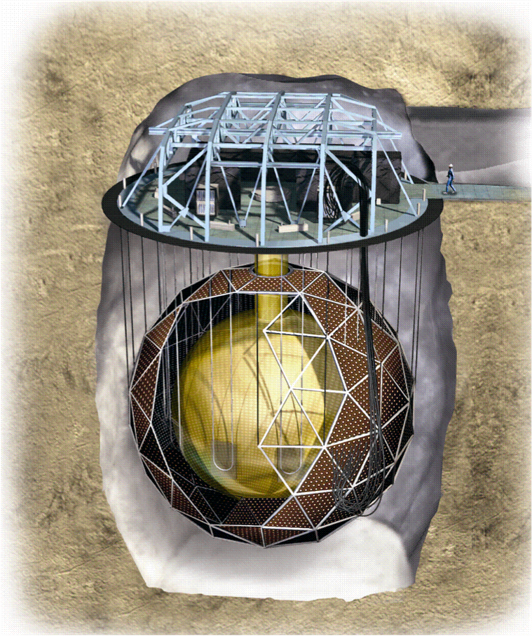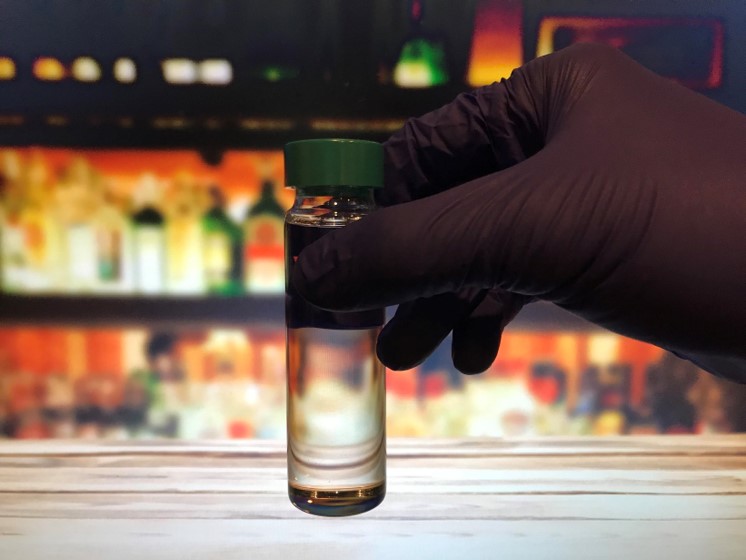The SNO+ Experiment
 The SNO+ Experiment is a versatile neutrino detector with the primary goal of searching for neutrinoless double beta decay (0vbb) . However, the high sensitivity, low backgrounds, and extreme radiopurity of the SNO+ detector allows for the experiment to have an extensive physics programme ranging from solar neutrinos to invisible nucleon decay. The SNO+ experiment is the direct successor to the Sudbury Neutrino Observatory (SNO) Experiment, which famously won the 2015 Nobel Prize in Physics for the observation of neutrino oscillations. Therefore, the SNO+ detector uses much of the same hardware as the original SNO experiment, albeit extensively modified and upgraded. The most notable upgrade is the replacement of heavy water (D2O) with liquid scintillator. This allows for a higher lightyield and greatly increased sensitivity to neutrino interactions within the detector.
The SNO+ Experiment is a versatile neutrino detector with the primary goal of searching for neutrinoless double beta decay (0vbb) . However, the high sensitivity, low backgrounds, and extreme radiopurity of the SNO+ detector allows for the experiment to have an extensive physics programme ranging from solar neutrinos to invisible nucleon decay. The SNO+ experiment is the direct successor to the Sudbury Neutrino Observatory (SNO) Experiment, which famously won the 2015 Nobel Prize in Physics for the observation of neutrino oscillations. Therefore, the SNO+ detector uses much of the same hardware as the original SNO experiment, albeit extensively modified and upgraded. The most notable upgrade is the replacement of heavy water (D2O) with liquid scintillator. This allows for a higher lightyield and greatly increased sensitivity to neutrino interactions within the detector.
SNOLAB
Cosmic rays, or the millions of high-energy particles bombarding each square meter of the planet every second, mimic the signals of neutrinos and 'drown out' the detector, making neutrino detection impossible. However, this cosmic ray 'background' can be removed by putting a lot of 'stuff' that can absorb cosmic rays between the detector and space. In the case of SNO+, the 'stuff' we use is 2km of Canadian Shield. The SNO+ detector is situated underground at the SNOLAB research facility. Originally built to house the SNO experiment, the SNOLAB facility has since expanded to be one of the deepest and cleanest underground research facilities in the world, housing nearly a dozen world-class neutrino and dark matter experiments. SNOLAB is located near Sudbury (Ontario) in Creighton Mine, an active nickle and copper mine run by Brazillian multinational mining corporation Vale.The SNO+ Detector
The main detector is a 6m diameter acrylic vessel (AV), to be filled with 780 tonnes of linear alkylbenzene, our liquid scintillator. Neutrino interactions within the AV are viewed by ~9800 photomultiplier tubes (PMTs), which are mounted on a steel PMT SUPport stucture (PSUP) outside of the AV. This steel structure is located in a ~20m tall cavity dug into the Canadian Shield 2km underground at SNOLAB. The cavity is filled with ultrapure water to reduce undesirable background events from trace amounts of uranium and thorium in the surrounding rock.Pictured below: The SNO+ Detector, imaged by one of the underwater calibration camera systems.

SNO+ Physics Programme
Neutrinoless Double Beta Decay
 The ultimate goal of SNO+ is the search for 0vbb. In order to do this, the liquid scintillator will be loaded with ~1300kg of Te-130, an isotope known to undergo double beta decay. Electrons emitted from the double beta decay will be amplifed by the liquid scintillator and observed with our PMTs, and the energies measured to see if any of the decays were neutrinoless. Double beta decays are very rare, so the immense quantity of isotope loaded into SNO+ gives a significant advantage over other 0vbb experiments.
The ultimate goal of SNO+ is the search for 0vbb. In order to do this, the liquid scintillator will be loaded with ~1300kg of Te-130, an isotope known to undergo double beta decay. Electrons emitted from the double beta decay will be amplifed by the liquid scintillator and observed with our PMTs, and the energies measured to see if any of the decays were neutrinoless. Double beta decays are very rare, so the immense quantity of isotope loaded into SNO+ gives a significant advantage over other 0vbb experiments.
Solar Neutrinos
The usage of liquid scintillator will allow for a lower energy threshold in SNO+ than other neutrino experiments. Therefore, SNO+ will be sensitive to pep and CNO neutrinos produced in the sun. The production rate of pep neutrinos in the sun is extremely well known, so a measurement of the pep neutrino flux at the Earth will show the "survival probability" of the original neutrino flavour and resolve an ongoing conflict between contending neutrino oscillation models. Meanwhile, the measurement of the CNO flux will give insight into the "solar metallicity problem", an unresolved issue regarding the metal content in the core of the Sun.Antineutrinos
SNO+ is able to detect antineutrinos through an inverse beta decay interaction that can occur inside the AV. Antineutrinos are created from radioactive materials in the crust and mantle of the Earth (geoneutrinos), as well as in nuclear reactors. A measurement of geoneutrinos will give insight into two properties of the Earth that are not well understood: the heating mechanism of the Earth, and the composition of the Earth's mantle and crust. SNO+ is also located near 3 local nuclear reactors. As the neutrino generation from nuclear reactors and their distances from SNO+ are very well known, this will allow for extremely precise neutrino oscillation measurements.Supernova Neutrinos
When the outward pressure due to fusion reactions in the core of a dying star is not enough to overcome the force of gravity from the outer envelope of the star, the envelope comes crashing into the core in what is known as a supernova. Over 99% of the energy of a supernova is released in the form of neutrinos. Furthermore, while the photons from the explosion are jumbled in the collapsing envelope, the neutrinos are expelled mostly unphased. Therefore, the neutrinos are not only the most representative signal of a supernova, but can act as a warning to astronomers of an imminant supernova. SNO+ will be a member of the Supernova Early Warning System (SNEWS), which is a collaborative effort between 8 neutrino experiments to detect supernovae in advance of their light signals.
are jumbled in the collapsing envelope, the neutrinos are expelled mostly unphased. Therefore, the neutrinos are not only the most representative signal of a supernova, but can act as a warning to astronomers of an imminant supernova. SNO+ will be a member of the Supernova Early Warning System (SNEWS), which is a collaborative effort between 8 neutrino experiments to detect supernovae in advance of their light signals.
Exotic Physics Searches
The extremely low-background conditions, high sensitivity, and low energy threshold of the SNO+ experiment allows for the detection capabilities of other beyond-the-standard-model physics. These can the search for invisible nucleon decay (decays of nucleons into modes where daughter products deposit no energy in the detector), and axion-like particles (hypothetical particles that can solve things such as the Strong CP problem). Previous page: Neutrino Physics Pictured above: The SNO+ Collaboration (2017)
Pictured above: The SNO+ Collaboration (2017)